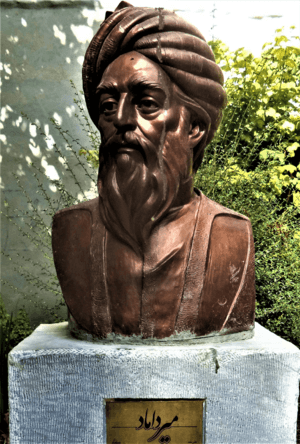Mir Damad facts for kids
Mir Damad (born around 1561, died 1631 or 1632) was a very important Iranian philosopher. His full name was Mir Mohammad Baqer Esterabadi. He was a key thinker in Islamic philosophy, following ideas from ancient Greek philosophers like Avicenna. Mir Damad was also a scholar of traditional Islamic sciences. He played a big part in the cultural rebirth of Iran during the Safavid dynasty. Along with his student Mulla Sadra, he helped found the famous School of Isfahan. His students even called him the "Third Teacher," after famous thinkers like Aristotle and al-Farabi.
Contents
Mir Damad's Big Ideas in Philosophy
Mir Damad made a huge impact on Islamic philosophy. He came up with a new way to think about time and how things came into being. He helped solve a big debate: was the world created at a certain time, or has it always existed?
Understanding "Atemporal Origination"
Mir Damad introduced the idea of huduth-e-dahri, which means "atemporal origination." This is a fancy way of saying that everything (except God) has two ways of starting. It has an eternal beginning and a temporal beginning. This means things exist in a way that is both timeless and within time.
Divine Wisdom and the School of Isfahan
Mir Damad also influenced a philosophy called al-falsafa al-yamani. This way of thinking was based on divine revelation and the sayings of prophets. It was different from the rationalism of the Greeks. He is widely known as the founder of the School of Isfahan. This school focused on a "divine wisdom" outlook, known as hikmat-i ilahi.
His Writings and Students
Mir Damad wrote many books on Islamic philosophy. Some of his famous works include Taqwim al-Iman (Calendars of Faith) and Kitab Qabasat al-Ilahiyah (Book of the Divine Embers of Fiery Kindling). In the latter, he explained his idea of atemporal origination. He also wrote poetry using the pen name Ishraq, which means "Illumination."
Besides Mulla Sadra, Mir Damad had many other important students. These included Seyyed Ahmad-ibn-Reyn-al-A’bedin Alavi and Qutb-al-Din Mohammad Ashkevari.
Mir Damad's writing style was often very complex. He used and even created difficult philosophical words. This meant his works needed a lot of study to understand them fully. He was called Mir Damad, which means "Groom of the King." This was because he married the daughter of Shah Abbas, a powerful ruler.
Mir Damad's Architecture Skills
Mir Damad was not just a philosopher; he was also an architect! He helped design the Masjide Shah (Shah Mosque) in Isfahan. This mosque used very advanced mathematical calculations.
The Amazing Dome of Shah Mosque
The geometry of the mosque's dome is truly special. It was designed so that any sound made at the base of the dome would echo. These echoes would bounce off hundreds of carefully planned corners inside the dome. All these sound waves would then meet at a single point in the center of the dome. Building such a precise dome in the 17th century was an amazing feat of engineering and art.
Mir Damad's Family
Mir Damad had a son named Seyed Ali Naghi Astarabadi. His grandson was Sayyid Mahdi bin Sayyid Ali Naqi. His daughter was married to Sayyid Ahmad ibn Zayn al-Abidin Alavi.
Mir Damad's Works
Mir Damad wrote many books. Here are some of his most well-known works:
- Taqwim al-Iman (Calendars of Faith)
- Kitab Qabasat al-Ilahiyah (Book of the Divine Embers of Fiery Kindling)
- Kitab al-Jadhawat (Book of Spiritual Attractions)
- Sirat al-Mustaqim (The Straight Path)
See also
- Islamic scholars
- List of Iranian scholars
- Sayyid Husayn Ahlati


